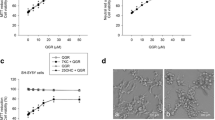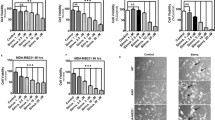Abstract
Cholesterol is essential for cell viability, and homeostasis of cellular cholesterol is crucial to various cell functions. Here we examined the effect of cholesterol depletion on apoptosis and the mechanisms underlying this effect in NIH3T3 cells. We show that chronic cholesterol depletion achieved with lipoprotein-deficient serum (LPDS) and 25-hydroxycholesterol (25-HC) treatment resulted in a significant increase in cellular apoptosis and caspase-3 activation. This effect is not due to a deficiency of nonsterol isoprenoids, intermediate metabolites of the cholesterol biosynthetic pathway, but rather to low cholesterol levels, since addition of cholesterol together with LPDS and 25-HC nearly abolished apoptosis, whereas addition of farnesyl pyrophosphate or geranylgeranyl-pyrophosphate did not reverse the cell viability loss induced by LPDS plus 25-HC treatment. These effects were accompanied by an increase in ERK, JNK and p38 MAPK activity. However, only the inhibition of p38 MAPK with the specific inhibitor SB203580 or the overexpression of a kinase defective MKK6 resulted in a significant decrease in apoptosis and caspase-3 cleavage induced by cholesterol depletion. Furthermore, LPDS plus 25-HC increased RhoA activity, and this effect was reversed by addition of exogenous cholesterol. Finally, overexpression of the dominant negative N19RhoA inhibited p38 MAPK phosphorylation and apoptosis induced by low cholesterol levels. Together, our results demonstrate that cholesterol depletion induces apoptosis through a RhoA- and p38 MAPK-dependent mechanism.
Similar content being viewed by others
References
Brown MS, Goldstein JL (1980) Multivalent feedback regulation of HMG CoA reductase, a control mechanism coordinating isoprenoid synthesis and cell growth. J Lipid Res 21:505–517
Goldstein JL, Brown MS (1990) Regulation of the mevalonate pathway. Nature 343:425–430
Quesney-Huneeus V, Alack HA, Siperstein MD, et al (1983) The dual role of mevalonate in the cell cycle. J Biol Chem 258:378–385
Habenicht AJR, Grommet JA, Ross R (1980) Relation of cholesterol and mevalonic acid to the cell cycle in smooth muscle and Swiss 3T3 cells stimulated to divide by platelet-derived growth factor. J Biol Chem 255:5134–5140
Fairbanks KP, Witte LD, Goodman DS (1984) Relationship between mevalonate and mitogenesis in human fibroblasts stimulated with platelet-derived growth factor. J Biol Chem 259:1546–1551
Siperstein MD (1984) Role of cholesterogenesis and isoprenoid synthesis in DNA replication and cell growth. J Lipid Res 252:1462–1468
Cuts JL, Scalpel TJ, Wanton J, Bankhurst AD (1989) Role of mevalonic acid in the regulation of natural killer cell cytotoxicity. J Cell Physiol 139:550–557
Garcia-Roman N, Alvarez AM, Toro MJ, Montes A, Lorenzo MJ (2001) Lovastatin induces apoptosis of spontaneously immortalized rat brain neuroblasts: Involvement of nonsterol isoprenoid biosynthesis inhibition. Mol Cell Neurosci 17:329–341
Padayatty SJ, Marcelli T, Shao TC, Cunningham GR (1997) Lovastatin-induced apoptosis in prostate stromal cells. J Clin Endocrinol Metab 82:1434–1439
Jones KD, Coulder WT, Hinton DR, et al (1994) Lovastatin induces growth inhibition and apoptosis in human malignant glioma cells. Biochem Biophys Res Commun 205:1681–1687
Dimitroulakos J, Yeger H (1996) HMG-CoA reductase mediates the biological effects of retinoic acid on human neuroblastoma cells. Nat Med 2:326–333
Satoh T, Isobe H, Ayukawa K, Sakai H, Nawara H (1996) The effects of pravastatin, an HMG-CoA reductase inhibitor, on cell viability and DNA production of rat hepatocytes. Life Sci 59:1103–1108
Michikawa M, Yanagisawa K (1999) Inhibition of cholesterol production but not of nonsterol isoprenoid products induces neuronal cell death. J Neurochem 72:2278–2285
Sponne I, Fifre A, Koziel V, Oster T, Olivier JL, Pillot T (2004) Membrane cholesterol interferes with neuronal apoptosis induced by soluble oligomers but not fibrils of amyloid-beta peptide. FASEB J 18:836–838
Yang L, Sinensky MS (2000) 25-Hydroxycholesterol activates a cytochrome c release-mediated caspase cascade. Biochem Biophys Res Commun 278:557–563
Lim HK, Kang HK, Yoo ES, et al. (2003) Oxysterols induce apoptosis and accumulation of cell cycle at G(2)/M phase in the human monocytic THP-1 cell line. Life Sci 72:1389–1399
Rusinol AE, Thewke D, Liu J, Freeman N, Panini SR, Sinensky MS (2004) AKT/protein kinase B regulation of BCL family members during oxysterol-induced apoptosis. J Biol Chem 279:1392–1399
Brown DA, London E (1998) Functions of lipid rafts in biological membranes. Annu Rev Cell Dev Biol 14:111–136
Chiloeches A, Usera F, Lasa M, Ropero S, Montes A, Toro MJ (1997) Effect of mevalonate availability on the association of G-protein alpha-subunits with the plasma membrane in GH4C1 cells. FEBS Lett 401:68–72
Ropero S, Chiloeches A, Montes A, Toro-Nozal MJ (2003) Cholesterol cell content modulates GTPase activity of G proteins in GH4C1 cell membranes. Cell Signal 15:131–138
Breusegem SY, Halaihel N, Inoue M, et al (2005) Acute and chronic changes in cholesterol modulate Na-Pi cotransport activity in OK cells. Am J Physiol Renal Physiol 289:154–165
Luegmayr E, Glantschnig H, Wesolowski GA, et al (2004) Osteoclast formation, survival and morphology are highly dependent on exogenous cholesterol/lipoproteins. Cell Death Differ 1:108–118
Bang B, Gniadecki R, Gajkowska B (2005) Disruption of lipid rafts causes apoptotic cell death in HaCaT keratinocytes. Exp Dermatol 14:266–272
Griadecki R (2004) Depletion of membrane cholesterol causes ligand-independent activation of Fas and apoptosis. Biochem Biophys Res Commun 320:165–169
Sarker KP, Maruyama I (2003) Anandamide induces cell death independently of cannabinoid receptors or vanilloid receptor 1: Possible involvement of lipid rafts. Cell Mol Life Sci 60:1200–1208
Biswas KK, Sarker KP, Abeyama K, et al (2003) Membrane cholesterol but not putative receptors mediates anandamide-induced hepatocyte apoptosis. Hepatology 38:1167–1177
Kyriakis JM, Avruch J (2001) Mammalian mitogen-activated protein kinase signal transduction pathways activated by stress and inflammation. Physiol Rev 81:807–869
Roux PP, Blenis J (2004) ERK and p38 MAPK-activated protein kinases: A family of protein kinases with diverse biological functions. Microbiol. Mol Biol Rev 68:320–344
Wada T, Penninger JM (2004) Mitogen-activated protein kinases in apoptosis regulation. Oncogene 23:2838–2849
Bar-Sagi D, Hall A (2000) Ras and Rho GTPases: A family reunion. Cell 103:227–238
Takai Y, Sasaki T, Matozaki T (2001) Small GTP-binding proteins. Physiol Rev 81:153–208
Kaibuchi K, Kuroda S, Amano M (1999) Regulation of the cytoskeleton and cell adhesion by the Rho family GTPases in mammalian cells. Annu Rev Biochem 68:459–486
Aznar S, Lacal JC (2001) Rho signals to cell growth and apoptosis. Cancer Lett 165:1–10
Malliri A, Collard JG (2003) Role of Rho-family proteins in cell adhesion and cancer. Curr Opin Cell Biol 15:583–589
Park HJ, Kong D, Iruela-Arispe L, Begley U, Tang D, Galper JB (2002) 3-hydroxy-3-methylglutaryl coenzyme A reductase inhibitors interfere with angiogenesis by inhibiting the geranylgeranylation of RhoA. Circ Res 91:143–150
Fessler MB, Arndt PG, Frasch SC, et al (2004) Lipid rafts regulates lipopolysaccharide-induced activation of Cdc42 and inflammatory functions of the human neutrophil. J Biol Chem 279:39989–39998
Senokuchi T, Matsumura T, Sakai M, et al (2005) Statins suppress oxidized low density lipoprotein-induced macrophage proliferation by inactivation of the small G protein-p38 MAPK pathway. J Biol Chem 280:6627–6633
Gingras D, Gauthier F, Lamy, S, Desrosiers RR, Beliveau R (1998) Localization of RhoA GTPase to endothelial caveolae-enriched membrane domains. Biochem Biophys Res Commun 247:888–893
Michaely PA, Mineo C, Ying YS, Anderson RG (1999) Polarized distribution of endogenous Rac1 and RhoA at the cell surface. J Biol Chem 274:21430–21436
Utech M, Hobbel G, Rust S, Reinecke H, Assmann G, Walter M (2001) Accumulation of RhoA, RhoB, RhoG, and Rac1 in fibroblasts from Tangier disease subjects suggests a regulatory role of Rho family proteins in cholesterol efflux. Biochem Biophys Res Commun 280:229–236
Girao H, Pereira P, Ramalho J, Quinlan R, Prescott A (2003) Cholesterol oxides mediated changes in cytoskeletal organisation involves Rho GTPases. Exp Cell Res 291:502–513
Sanz-Moreno V, Casar B, Crespo P (2003) p38alpha isoform Mxi2 binds to extracellular signal-regulated kinase 1 and 2 mitogen-activated protein kinase and regulates its nuclear activity by sustaining its phosphorylation levels. Mol Cell Biol 9:3079– 3090
Rothblat GH, Bamberger M, Phillips MC (1986) Reverse cholesterol transport. Methods Enzymol 129:628–644
Gamble W, Vaughan M, Kruth HS, Avigan J (1978) Procedure for determination of free and total cholesterol in micro- or nanogram amounts suitable for studies with cultured cells. J Lipid Res 19:1068–1070
Coleman ML, Sahai EA, Yeo M, Bosch M, Dewar A, Olson MF (2001) Membrane blebbing during apoptosis results from caspase-mediated activation of ROCK I. Nat Cell Biol 3:339–345
Galaria II, Fegley AJ, Nicholl SM, Roztocil E, Davies MG (2004) Differential regulation of ERK1/2 and p38(MAPK) by components of the Rho signaling pathway during sphingosine-1-phosphate-induced smooth muscle cell migration. J Surg Res 122:173–179
Yamauchi J, Tsujimoto G, Kaziro Y, Itoh H (2001) Parallel regulation of mitogen-activated protein kinase kinase 3 (MKK3) and MKK6 in Gq-signaling cascade. J Biol Chem 276:23362–23372
Landis MS, Patel HV, Capone JP (2002) Oxysterol activators of liver X receptor and 9-cis-retinoic acid promote sequential steps in the synthesis and secretion of tumor necrosis factor-a from human monocytes. J Biol Chem 277:4713–4721
Maxwell KN, Soccio RE, Duncan EM, Sehayek E, Breslow JL (2003) Novel putative SREBP and LXR target genes identified by microarray analysis in liver of cholesterol-fed mice. J Lipid Res 44:2109–2119
Kawabe J, Okumura S, Lee MC, Sadoshima J, Ishikawa Y (2004) Translocation of caveolin regulates stretch-induced ERK activity in vascular smooth muscle cells. Am J Physiol Heart Circ Physiol 286:1845–1852
Kabouridis PS, Janzen J, Magee AL, Ley SC (2000) Cholesterol depletion disrupts lipid rafts and modulates the activity of multiple signaling pathways in T lymphocytes. Eur J Immunol 30:954–963
Furuchi T, Anderson RG (1998) Cholesterol depletion of caveolae causes hyperactivation of extracellular signal-related kinase (ERK). J Biol Chem 273:21099–21104
Ares MP, Porn-Ares MI, Moses S, Nilsson J, et al (2000) 7beta-hydroxycholesterol induces Ca(2+) oscillations, MAP kinase activation and apoptosis in human aortic smooth muscle cells. Atherosclerosis 153:23–35
Yoon JH, Canbay AE, Werneburg NW, Lee SP, Gores GJ (2004) Oxysterols induce cyclooxygenase-2 expression in cholangiocytes:implications for biliary tract carcinogenesis. Hepatology 39:732–738
Jans R, Atanasova G, Jadot M, Poumay Y (2004) Cholesterol depletion upregulates involucrin expression in epidermal keratinocytes through activation of p38. J Invest Dermatol 123:564–573
Bulavin DV, Saito S, Hollander MC, et al (1999) Phosphorylation of human p53 by p38 kinase coordinates N-terminal phosphorylation and apoptosis in response to UV radiation. EMBO J 18:6845–6854
Ono K, Han J (2000) The p38 signal transduction pathway: Activation and function. Cell Signalling 12:1–13
Marinissen MJ, Chiariello M, Gutkind JS (2001) Regulation of gene expression by the small GTPase Rho through the ERK6 (p38 gamma) MAP kinase pathway. Genes Dev 15:535–553
Wang J, Fan J, Laschinger C, Arora PD, Kapus A, Seth A, McCulloch CA (2005) Smooth muscle actin determines mechanical force-induced p38 activation. J Biol Chem 280:7273–7284
Agarwal B, Halmos B, Feoktistov AS, et al (2002) Mechanism of lovastatin-induced apoptosis in intestinal epithelial cells. Carcinogenesis 23:521–528
Kaneta S, Satoh K (2003) All hydrophobic HMG-CoA reductase inhibitors induce apoptotic death in rat pulmonary vein endothelial cells. Atherosclerosis 170:237–243
Rombouts K, Kisanga E, Hellemans K, Wielant A, Schuppan D, Geerts A (2003) Effect of HMG-CoA reductase inhibitors on proliferation and protein synthesis by rat hepatic stellate cells. J Hepatol 38:564–572
Author information
Authors and Affiliations
Corresponding author
Rights and permissions
About this article
Cite this article
Calleros, L., Lasa, M., Rodríguez-Álvarez, F.J. et al. RhoA and p38 MAPK mediate apoptosis induced by cellular cholesterol depletion. Apoptosis 11, 1161–1173 (2006). https://doi.org/10.1007/s10495-006-6980-3
Published:
Issue Date:
DOI: https://doi.org/10.1007/s10495-006-6980-3




